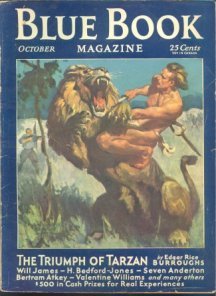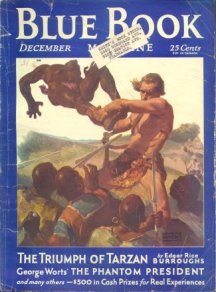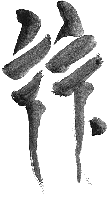
Official Edgar Rice Burroughs Tribute and Weekly Webzine Site
Since 1996 ~ Over 15,000 Web Pages in Archive
Presents
Volume 1703b
Themes And Variations
The Tarzan Novels Of Edgar Rice Burroughs
#15 Tarzan Triumphant


Part 3: Two Peas and the Pod



by R. E. Prindle
The ease with which ERB shifts from one complicated subject to another is truly remarkable; no less so in the facility he has for organizing these matters into a few lines or paragraphs. No one can do this without a firm grasp of his subject matter. ERB is simply one of the best informed writers of his era.In a little less than a page ERB summarizes the Torrio-Capone years in Chicago from the beginning of Prohibition to 1930 while incorporating a fictional history of his character, Danny 'Gunner ' Patrick. Patrick as his name indicates is Irish. He was part of the Dion O' Banion gang led by Bugs Moran after O' Banion's demise in 1924. According to Burroughs Patrick took part in the St. Valentine's Day Massacre in 1929.
...but Danny Patrick was ambitious. For years he had been the right hand of a Big Shot. He had seen his patron grow rich-- "lousy rich" according to Danny's notion-- and he had become envious.Patrick is not only not a nice guy, he is definitely not a nice guy. For my tastes ERB is much too tolerant of a man he describes as a psychopathic killer. 'Many of the Big Shot's enemies, and several of his friends' implies that Patrick has many, perhaps dozens, of murders to his credit yet Burroughs is going to have Tarzan befriend this guy.
So Danny double crossed the Big Shot, went over to the other side, which, incidentally, boasted a bigger and better Big Shot, (Al Capone) and was a party to the hijacking of several truck loads of booze belonging to his former employer.
--------------
Many of the Big shots enemies, and several of his friends, had Danny (Danny had) taken for a ride. He knew the power of the Big Shot, and he feared him. Danny did not want to go for a ride himself, but he knew that if he remained in dear old Chi he would go the way of all good gunmen much too soon to suit his plans.While O' Banion was done in in 1924 by the Capone gang, being succeeded by Moran, ERB seems to telescope the years reversing things so that O'Banion is still alive after the 1929 St. Valentine's Day Massacre -- 'The Day Chicago Died.' ERB is clearly following and thinking about the situation in Chicago as he says, p.27:
(Patrick) also knew that sooner or later, the Big Shot would have a grand funeral with truck loads of flowers and, at least, a ten thousand dollar casket.Underworld funerals were prodigious affairs. There is a certain irony in the fact that Dion O'Banion ran a flower shop. As a big crime figure it would be expected that the flowers for those expensive funerals would come from his shop. Is it any wonder Patrick was taking so many people for a ride. O'Banion had a good racket going there.Not wanting to be taken for a ride himself Patrick had opted for an extended vacation taking his typewriter with him. A Chicago typewriter was, of course, a Thompson sub-machine gun, Tommy gun. The Chicago underworld quickly adopted the Tommy gun which was new at the time, which made those Dick Tracy comic strips so thrilling. Although one has come to accept the Chicago hoodlum story as a commonplace if one actually thinks about it the open war between the underworld and legitimate society is so startling that one should be appalled. ERB like the rest of his contemporaries seems to have taken the fact in stride even, in his case, making Patrick a hero.
It is almost as though he made Patrick the dark side of the mild mannered Geology professor, Lafayette Smith. In this series of books from Invincible to Lion Man ERB explores the split or dual personality as examined in Robert Louis Stevenson's Dr. Jekyll And Mr. Hyde. Convinced as ERB is that the Animus is represented by two archetypes, with which I find no difficulty other than it can be three, four or more, in this story as usual he divides the two aspects of personality between two characters.
Lafe Smith is clearly an alter ego of Burroughs. Borrowing rrom ERB's own experience he says of Smith, p. 11:
...Lafayette Smith, A.M., Ph.D., Sc.D, professor of geology at the Phil Sheridan Military Academy...Here we have ERB as he would like to have been with a string of degrees after his name. First in this dream life he is a professor of Geology at the Phil Sheridan Military Academy which sounds pretty impressive but then he is mysteriously down graded from a professor to a mere instructor (which he was in fact) for a schoolyear -- nine months -- at an inconspicuous western military academy. Thus fantasy collides with the reality.
---
For a school year now, he had been an instructor in an inconspicuous western military academy...Another fantasy, now Smith was on his way to achieve another cherished ambition that of going to Africa to study the Great Rift Valley perhaps as ERB himself might have liked to have done but which he never did.
So ERB has his ego ideals, his Jekyll and Hyde sides going as pals to Africa. As Tarzan is also an ego ideal we have an actual trinity. Jekyll and Hyde and what? God? David Adams who is a pretty thorough Jungian is mystified by the lack of the benevolent old man in Burroughs work who according to Jungian psychology should be there. This is more than likely a very involved question but I am going to suggest that possibly characters like Tarzan and John Carter serve in that capacity as Old Man/Jekyll figures while the actual Old Man figures who are betrayers serve perhaps as Hydelike figures as represented by his father..
In real life Burroughs 'old man' his father was a betrayer who had little good to say about his son even to the extent of defaming him to all and sundry. So, it's possible that ERB split the Jungian benevolent Old Man figure into Jekyll like Tarzan and John Carter and his father into the Hyde like Old Man character. As he was conflicted with a love/hate relationship with his father it would be easier for him not to mention his father by name. I offer this interpretation only as a suggestion and do not insist on it, still it is a possible solution to the problem perhaps leading to a full solution.
You can take the boy out of Chicago but you can't take the Chicago out of the Boy. ERB was always fascinated by slang. Gunner Patrick gives him the opportunity for extensive and amusing word play. The criminal culture from which Patrick comes has what amounts to a patois. At one point ERB calls it by the French term of argot. Even though he is pronouncing English words that the English speaking characters can recognize the meanings he attaches to the words are beyond the comprehension of his auditors. Thus one has the interesting effect of the cultural clash between two examples of what should be the same culture but is not.
Of course ERB is in full command of not only both these cultures but seemingly of all cultures. In his zany multi-cultural world he is the Master of Cultures. I pretend to the succession of ERB.
Thus disembarking from a ship the bright and dark sides of ERB tramp across Africa in the direction of the Great Rift Valley. Perhaps like Kitchener they came down the Nile to Khartoum and cut up the Blue Nile to Ethiopia. Now Burroughs has to integrate his master alter ego, Tarzan, into the Jekyll and Hyde pair.
A psychological interpretation is that Tarzan must accept the Hyde of Burroughs' personality as well as the Jekyll. Indeed, Tarzan seems to respect the Hyde side much more than he does the clown like but educated Jekyll side.
As the story is told Tarzan hears the sound of a machine gun and goes to investigate. Patrick had fired into the bush hoping to hit a lion nosing about the safari camp. He succeeds in temporarily scaring it away, giving Tarzan time to locate the camp.
The lion returns. Imagine this scene. Patrick with his Tommy gun is standing under the convenient tree, while Smith stands behind him with his nickel plated .32 that he doesn't even know how to aim. Here ERB's dark side is in command while his incompetent but intelligent bright side is subordinate to the dark.
As Patrick fires on the lion the Tommy gun jams leaving both sides of Burroughs alter-ego defenseless. At this time the Master Alter Ego falls on the lion from the tree killing him and saving the lives of the subordinate alter egos, Patrick and Smith. Patrick is Irish and the more aggressive while one presumes Smith is English and more passive. Thus a major theme of Irish and English which runs throughout the corpus is here represented. While ERB claimed to be 'pure' English he was actually English only on his father's side while being Pennsylvania Dutch, in other words, Rhineland German, and Irish on his Mother's side. The Irish surfaces not only here but in the following year when he assumed his Irish ancestral name of John McCulloch to write Pirate Blood. Also as David Adams points out the killing of the lion puts the seal on the relationship between Tarzan, Smith and Patrick.
In the same period of time he wrote Pirates Of Venus and Pirate Blood. Although pirates had figured in his early writing as The Black Pirates Of Barsoom and the pirates of Pellucidar unless I'm mistaken this sudden efflorescence of interest in pirates has to do with the 'pirating' of Tarzan by MGM.
While not introducing himself Tarzan peremptorily gives the pair some instruction on how to comport themselves in the jungle then disappears up his tree.
The next time Tarzan and Patrick meet is a bonding session in which Tarzan accepts Burroughs' dark side, Patrick.
Tarzan is squatting on the edge of a cliff observing Capietro and Stabutch in their camp below. The ground gives way precipitating Tarzan over the edge. He attempts to save himself by grabbing the chance tree growing out of the cliff face- the chance tree, even here Burroughs equates trees with safety- but the tree gives way. Tarzan falls through the grass roof of a hut landing safely. He immediately is engulfed by the minions of Capietro.
Now, having lunch under another tree not too far away, yards actually, is Gunner Patrick. His attention called to the ape-man who he had previously not noticed he gets up to investigate. Aiding Tarzan he lets loose with a blast from the Thompson. He succeeds in dispersing the crowd as well as Capietro and Stabutch. This is almost comical: Tarzan shouts to Patrick to not go away, he'll be right up. Good as his word he appears above.
Now comes this very interesting bonding session in which Tarzan accepts Patrick. P. 98:
The "Gunner" was waiting for him upon the summit of the cliff directly behind the village, and for the second time these strangely dissimilar men met- dissimilar, and yet, in some respects, alike. Each was ordinarily quiet to taciturnity, each was self-reliant, each was a law unto himself in his own environment; but there the similarity ceased for the extremes of environment had produced psychological extremes as remotely separated as the poles.Now Burroughs signed his contract with MGM on April tenth of 1931 while he didn't finish Triumphant until May twentieth so he had forty days in which to realize his mistake. If he did realize his error so quickly it might account for some of the misanthropic bitterness in the above passage and elsewhere. Filching his character would certainly be considered a grand meanness. On the other hand his misanthropic interpretation was a continuation of his long standing dislike of men and civilization.
The ape-man had been reared amidst scenes of eternal beauty and grandeur, his associates the beasts of the jungle, savage perhaps, but devoid of coarse, petty jealousy, treachery, meanness, and intentional cruelty; while the "Gunner" had known naught but the squalid aspects of scenery defiled by man, of horizons grotesque with the screaming atrocities of architecture, of an earth hidden by concrete and asphaltum and littered with tin cans and garbage, his associates in all walks of life activated by grand and petty meannesses unknown to any but mankind.It is of interest that both Patrick and Tarzan have killed many men. Some of Tarzan's kills, quite frankly, verge on the psychopathic. I can't get over how he literally ripped a man's head off his shoulders in Ant Men. Of course, he may have merely underestimated his strength being a fourth his size but having his former strength.
Nevertheless both are laws unto themselves in their own domains so theoretically they can do as they please. Still, and I don't know how to interpret this, 'the extremes of environment had produced psychological extremes as remotely separated as the the poles. I'm clear on Patrick's extreme but I'm not sure which extreme Tarzan represents.
These extremes were caused by the differences in the environments of the two men. Tarzan was raised amongst beauty, while Patrick was raised amongst squalor. As Burroughs roamed over Chicago, and it seems certain he searched out nooks and crannies, he was appalled by the 'screaming atrocities of architecture'. Chicagoans have been quite proud of their architects and architectures so Burroughs critique is quite different. The paving over of the environment bothered him as much as it does me. We no longer see the tin cans and bottles but the dumping of garbage wherever certain people will goes on.
Tarzan was raised among the 'noble' beasts while Patrick was raised essentially among thieves and cheats.
Still, environment aside both men had many kills or murders to their credit. Seems like a double standard to absolve Tarzan while condemning Patrick especially since each is obviously a product of their environment while neither therefore is inherently good regardless of where they were raised.
Perhaps Tarzan kills only for just reasons, of his own reckoning as he is a law unto himself, while Patrick kills for gain is where the difference lies. Perhaps that is the difference between constituted society and the criminal world. There are times when the most mild mannered and best of men and women must kill, whether in the individual or collective sense. Burroughs brings this out when Lafe Smith attempts to liberate Lady Barbara and Jezebel from the Midianites. As he faces the Midianites with his .32 a cultured English voice comes down from the cross telling him that he is going to have to kill someone if he and the women wish to survive.
Perhaps this scene isn't just entertainment but Burroughs relating a hard fact of life. No matter how good you may be a situation in life will appear when you will have to do that which goes against everything you believe if you wish to survive. Such is the West's situation in the world today; commit suicide yourself or shoot to kill. Sometimes it comes down to that; left multi-culturalism or no.
This scene may be a very important psychological moment for ERB. There is wry truth in Tarzan's next utterance to Patrick: "'A machine gun has its possibilities,' said the ape-man with the flicker of a smile.'"
Perhaps ERB is in some midlife reevaluation. The scene with his alter ego Smith's entry into Midian is laden with symbolism also. Let's see how Burroughs handles that as he and Fate continue to weave the warp and woof of this remarkable tapestry to bring out the pattern.
Continued in Part 4: Lafe Smith Born Again
Themes And Variations: The Tarzan Novels Of Edgar Rice Burroughs
|
Introduction |
Lady Barbara Drops In |
Two Peas & the Pod |
Born Again Lafe Smith |
In the Footsteps of the Lord |
Threads & Strands of the Web |
R. E. Prindle welcomes your comments at:
dugwarbaby@yahoo.com
|
and Follow the Navigation Chart for the Entire Series of Articles |
|
Differing viewpoints are welcome. |
|
are not necessarily those held by Edgar Rice Burroughs, Inc. |


BILL HILLMAN
Visit our thousands of other sites at:
BILL AND SUE-ON HILLMAN ECLECTIC STUDIO
ERB Text, ERB Images and Tarzan® are ©Edgar Rice Burroughs, Inc.- All Rights Reserved.
All Original Work ©1996-2007/2010 by Bill Hillman and/or Contributing Authors/Owners
No part of this web site may be reproduced without permission from the respective owners.